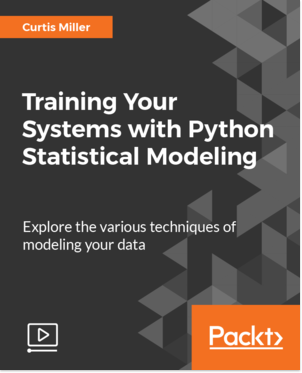This post is actually months late, but like with my last video course announcement, it’s better late than never. And besides, of my video courses, I had the most fun writing this one.
Last year I started publishing video courses with Packt Publishing. These courses formed a series of introductory courses for data analysis using Python, starting with Unpacking NumPy and Pandas and then, in the fall of last year, Data Acquisition and Manipulation with Python. These courses were about obtaining and managing data. My new course is the first course showing what you can do with data.
In this course I cover statistics and machine learning topics. The course assumes little knowledge about what statistics or machine learning involves. I touch lightly on the theory of statistics and machine learning to motivate the tasks performed in the videos.
In my four hour course I talk about
- Classical statistical inference, from both frequentist and Bayesian perspectives
- Machine learning principles, from what machine learning involves to evaluating the results of predictive algorithms
- Classification using algorithms, including decision trees, support vector machines, neural networks, and many more methods
- Regression with linear models, neural networks, and more
- Clustering using
-means, hierarchical clustering, and spectral clustering, with methods for evaluating results
- Dimensionality reduction with principal component analysis, singular value decomposition, and other methods
These videos are example intensive; the software is presented in the context of a particular problem involving real data. When I talk about theory I often use visualizations to explain the concepts. Most of the time in the course I’m performing a demonstration that the viewer can follow.
The videos in the course–narrated by me–include not only an explanation of the topic at hand but interactive demonstrations, so viewers can see how to use the software and follow along if they so desire. The video course includes the Jupyter notebooks I use in my demonstrations; viewers can run my code blocks to replicate my results, and edit them for their own experimentation.
You can buy the course on Packt’s website. There is currently a sale on Packt’s website so you can buy the entire course for $10 (compared to the typical retail price of $125), but the sale ends soon! If the price of the course is an obstacle, perhaps consider watching it on Mapt, Packt’s subscription service, which gives you access not only to all my courses but everything Packt has published (and they publish a ton of stuff), along with one free book of your choice to keep every month (likely without any DRM; just a plain ol’ PDF). (I also hear that Packt’s videos are available on other services, such as Lynda, but don’t quote me on that.)
I thank Packt for publishing this course. I also thank my editor, Viranchi Shetty, for offering feedback and keeping me on schedule. The editors at Packt had a big impact on the final product.
If you like my blog and would like to support me, perhaps consider purchasing the course. If you have no need for it or don’t have the money to spend (which I understand completely; I don’t live a life of glamour myself, being a graduate student), I’d love for you to spread the word about the course. Tell a friend wanting to get started in data analysis or data science, or even share this post on Facebook or Twitter or whatever your preferred social network is. Directing more eyes to the course helps. Write a review if you have watched it; I would love to hear your feedback, both positive and negative (though if negative, be gentle and constructive please).
My website has a new page for the new course here.
Thanks for reading! Stay tuned for my announcement of the final course in the series, which discusses particular machine learning applications (NLP, computer vision, and case studies).
If you want to know more about what the course is like, below are some of the videos included in the course.


One thought on “Learn Basic Python and scikit-learn Machine Learning Hands-On with My Course: Training Your Systems with Python Statistical Modelling”